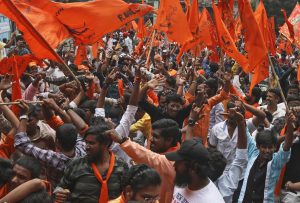On April 20, bulldozers rolled into the north Delhi neighborhood of Jahangirpuri on the orders of local authorities. The bulldozers razed several buildings in the area, including the entrance gate of a mosque as well as homes and shops of Muslims.
While local police and political officials claimed that the structures were being bulldozed as they were illegal, authorities stopped a bulldozer from mowing down the entrance of a Hindu temple that was situated just 50 meters from the mosque.
It is evident that the bulldozing activity was aimed at intimidating Muslims only, destroying their homes, livelihoods, and places of worship. It is part of a systematic campaign by Hindutva activists to wipe out Muslims and their way of life.
Among those whose livelihood was destroyed on Wednesday was 42-year-old Aijaz. His wooden cart, which he used to use to sell vegetables in the neighborhood, was missing. Among the rubble of buildings and shops in Jahangirpuri were Aijaz’s life and means of livelihood lay in pieces — along with his dreams of being a Muslim in India.
Only a few days earlier, communal violence broke out in Jahangirpuri when Hindutva activists participating in a procession to mark a religious Hindu festival, Hanuman Jayanti, reportedly attempted to hoist a saffron flag in front of a local mosque. Clashes between Hindus and Muslims followed, during which both sides engaged in stone-pelting and arson. Some vehicles were also burnt.
Such violence is usually portrayed as spontaneous. However, the incidents are often planned. Processions through Muslim neighborhoods, hoisting flags or shouting religious slogans or prayers near mosques is often aimed at instigating Muslims and provoking violence. It is not rare in today’s India.
Days prior to the clashes at Jahangirpuri, the Hindu festivals of Navratri and Ram Navami, saw several episodes of violence, harassment, and provocation of Muslims snowballing across India.
In Gujarat, one person was killed during the communal clashes. In Madhya Pradesh, according to official figures, 77 people were arrested. Reports on social media claimed that most of the arrested were Muslims. There were clashes in West Bengal’s Howrah too. In Jharkhand, stone-pelting resulted in injury to many, forcing the police to deploy on streets in large numbers.
Video footage of sword-brandishing Hindu mobs hoisting a flag at a mosque in Bihar’s Muzaffarpur district shows Muslims watching the desecration of their place of worship quietly, even helplessly.
In Madhya Pradesh’s Khargone district, 5,000 Hindus marching in a Ram Navami procession thronged a mosque and chanted anti-Muslim slogans there. Clashes followed and according to local Muslims, their homes were looted and at least 10 were set ablaze.
Given the support they enjoy from the state, Hindutva activists are unafraid of facing consequences or legal repercussions. Over the past month Hindutva mobs have been seen brandishing swords at processions and desecrating mosques. Such provocative violence is happening during the month of Ramzan, and often when Muslims are readying themselves to break their fast. The brazenness of Hindutva mobs is disturbing.
In videos shared across social media platforms, Hindus can be seen proudly flaunting swords and threatening to use them to kill and maim Muslims. The pride and joy they display at their destruction of Muslim-owned businesses and houses is distressing.
Recent months have also seen a surge in warnings of genocide issued by Hindutva religious leaders. Religious leaders have made more than 18 calls for abduction, rape, and genocide of Muslims, and boycott of their businesses. They have called for wiping out Islamic culture in India. These leaders are using ordinary people as their foot-soldiers to achieve their goal of establishing a Hindu state in India.
At ‘Dharam Sansads or religious conclaves, men wearing saffron scarves and robes brandish swords, metal rods, and pistols and shout incendiary anti-Muslim slogans. This is visible across India.
Meanwhile Prime Minister Narendra Modi has remained silent, prompting leaders of 13 opposition parties to condemn him for not speaking up against the surging violence in the country. The ruling Bharatiya Janata Party (BJP) and its affiliate organizations openly target Muslims across India and have benefited enormously from such polarization at elections.
In May this year, Modi will complete eight years as India’s prime minister. According to an independent hate crime tracker over 400 hate crimes were carried out against Muslims in India in the last four years.
Two organizations linked to the BJP that are at the forefront of the anti-Muslim violence are the Vishwa Hindu Parishad and the Bajrang Dal. Under the garb of celebrating Hindu festivals, these organizations carry out organized violence that is well-planned and coordinated targeting Muslims.
During the recent festivals, these Hindutva outfits demanded and in many places enforced a ban on activities such as eating meat that are part of Muslim culture. This wiping out of Muslims and their way of life has left the community dispirited.
Many like Aijaz who lead a hand to mouth existence are increasingly aware that their ability to earn a livelihood is at stake in Modi’s India.
“I owned a wooden cart, what damage was I doing to anyone?” he told The Diplomat. “First [they destroyed] my cart and then my one-room home. Where will we go? Every day is a new struggle because of people who hate us. Don’t they see we’re dying?”

































